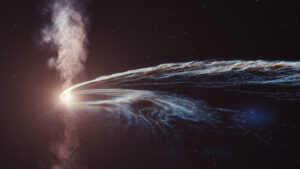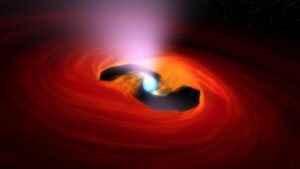I am a postdoctoral researcher at Curtin University interested in accreting compact objects. My research ranges from theoretical modelling of explosions on the surface of neutron stars, to observations of neutron stars and black holes in binary systems, to radio observations of stars being destroyed by supermassive black holes at the center of galaxies. I am a keen advocate for diversity and inclusion in STEM, and currently serve as the Chair of the ICRAR-Curtin development committee.
At ICRAR my research primarily focusses on what happens when a star is destroyed by a supermassive black hole at the center of a galaxy (pictured). These tidal disruption events cause the material that was once an unlucky star to spiral in towards the black hole, emitting energy (light) before being swallowed. Only about half of the star actually ends up being “eaten” by the black hole, while the other half gets thrown out into the surrounding regions. This ejected material interacts with the gas and dust that lives around the black hole, and emits energy in the form of radio emission. It is this radio emission that I search for, which telescopes such as the Australia Compact Telescope Array and the Very Large Array.

A star being ripped apart by a supermassive black hole. Image credit: DESY, Science Communication Lab.
Observing this radio emission helps us understand how the material was ejected by the black hole, and the circumstances surrounding the death of the star that was destroyed. The way that the ejected material interacts with the material surrounding the black hole also helps us measure the distribution of material in the central region of galaxies millions of light-years away, which is otherwise extraordinarily difficult to measure.
During my PhD in 2020 I caught an elusive accreting neutron star (pictured) as it entered outburst, in an international collaborative effort involving five groups of researchers, seven telescopes (five on the ground, two in space), and 15 collaborators. It was the first time such an event was observed in this detail – in multiple frequencies, including high-sensitivity measurements in both optical and X-ray.
The physics behind this ‘switching on’ process has eluded physicists for decades, partly because there are very few comprehensive observations of the phenomenon. I caught one of these accreting neutron star systems in the act of entering outburst, revealing that it took 12 days for material to swirl inwards and collide with the neutron star, substantially longer than the two- to three-days most theories suggest.

An accreting pulsar. Image credit: NASA/JPL-Caltech
In an ‘accreting’ neutron star system, a pulsar (a dense remnant of an old star) strips material away from a nearby star, forming an accretion disk of material spiralling in towards the pulsar, where it releases extraordinary amounts of energy – about the total energy output of the sun in 10 years, over the period of a few short weeks. The telescopes involved include two space observatories: the Neils Gehrels Swift X-ray Observatory, and the Neutron Star Interior Composition Explorer on the International Space Station; as well as the ground based Las Cumbres Observatory network of telescopes, and the South African Large Telescope.
ICRAR Statement
The content of this page is maintained by Adelle Goodwin, please contact them with any questions or comments on this content.